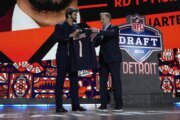WASHINGTON — “Are you done?”
My wife wanted to know if I was ready to go to bed. There were still a couple minutes left on the clock in Monday night’s tilt between the Pittsburgh Steelers and Cincinnati Bengals, a sordid, ugly display of football that saw players from both sides carted off the field while others suffered documented brain injuries. Nevertheless, I wanted to watch the final drive. Not to see who won, not because I was interested as a fan. Just because I needed to know if any action was enough to warrant an ejection and, if not, if anyone else was going to be severely — possibly permanently — injured.
Her question felt heavier through the prism of not just this game, but the entire year. From the “everyday” injuries such as Aaron Rodgers’ broken collar bone to the somehow-these-are-still-happening ones, like the obscene hit Rodgers’ teammate Davante Adams took from Danny Trevathan earlier this year. Am I done, with all of this?
This isn’t fun anymore. Watching the NFL isn’t fun. If you find yourself disagreeing with that, how are you rationalizing to yourself what happened Monday night?
Early on, there was the unintentional type of hit that reminds us that, no matter how much we try to clean up the game, no matter how many equipment safety advances are made, football will remain an inherently dangerous sport with the chance to ruin a life at a moment’s notice. Steelers linebacker Ryan Shazier — one of the best defenders in the league — ducked his head ever-so-slightly at the wrong time on a routine tackle, a split-second decision made all the time, but one that could have cost him the use of his legs.
Shazier fell to the ground, immediately grabbing at his lower back, then rolled over, flexing his right hand while looking down desperately at his legs, which would not move. It was terrifying to watch, but even more so when you consider just how simple the play was that caused it, one that didn’t seem out of the ordinary until the scene following it unfolded.
Consider the response on Twitter, where nearly anyone with a shred of a conscious lost all interest in the game itself, just hoping that Shazier, a father and husband, would be able to walk again.
But then, there was the obvious, intentional, blindside hit that JuJu Smith-Schuster leveled on serial headhunter Vontaze Burfict, lowering the crown of his helmet into Burfict’s jaw. The hit left Burfict sprawled on the ground, bewildered, grasping for anything to hold onto before he was carted off on a board.
In college, that’s an immediate ejection and, if it happened in the second half, a suspension for the first half of the player’s next game. In the NFL, it’s a 15-yard penalty and an eventual fine. Clearly that punishment is not disincentive enough to keep these things from happening, especially considering that Bengals defender George Iloka speared Steelers receiver Antonio Brown with the same kind of hit later on the same drive (Iloka was also not ejected). While punishment came down from the league office Tuesday afternoon in the form of single-game suspensions for both hits, this is the type of play that shouldn’t need individual, after-the-fact adjudication.
The NFL’s lack of severe enforcement against these horrendous plays is proof enough that its supposed care for player safety is nothing more than lip service. The fact that the league only punished Rob Gronkowski with a single game suspension for his egregious, well-after-the-whistle hit on a completely defenseless player lying on the ground after the whistle speaks clear as day to the league’s priorities in keeping stars on the field rather than holding them accountable or meaningfully addressing its concussion crisis.
This game is hard to watch for a number of reasons…terrible for the NFL and the game of football overall.
— Troy Aikman (@TroyAikman) December 5, 2017
The media is complicit in this as well. The ESPN headline for Monday night’s game reads “Steelers win physical game against Bengals.” That’s it. “Physical.” Even through our descriptions of these plays, we’ve accepted potential career-ending, life-changing violence as not just an understood part of the game, but a celebrated one. The word “physical” is a positive one in football. Just look at draft reports on this year’s defensive first-round picks: safety Jamal Adams is a “physical tone-setter”; linebacker Jarrad Davis is a “tough kid” who has “got the physical traits”; safety Malik Hooker is even knocked for being “not overly physical against the run.”
This is where the NFL will eventually be forced to choose its identity. Weighing suspensions after the fact and slowly ramping up penalties only to quell outrage instead of addressing the root issue hasn’t worked for the league so far, and it won’t in the future. The league can’t have it both ways. It can either accept the “physicality” — and the lawsuits, and loss of viewership on one side — or it can make real, meaningful changes to the sport, which will inevitably alienate another side of its viewership.
In its current form, it is not only unsustainable — it has become unwatchable.




